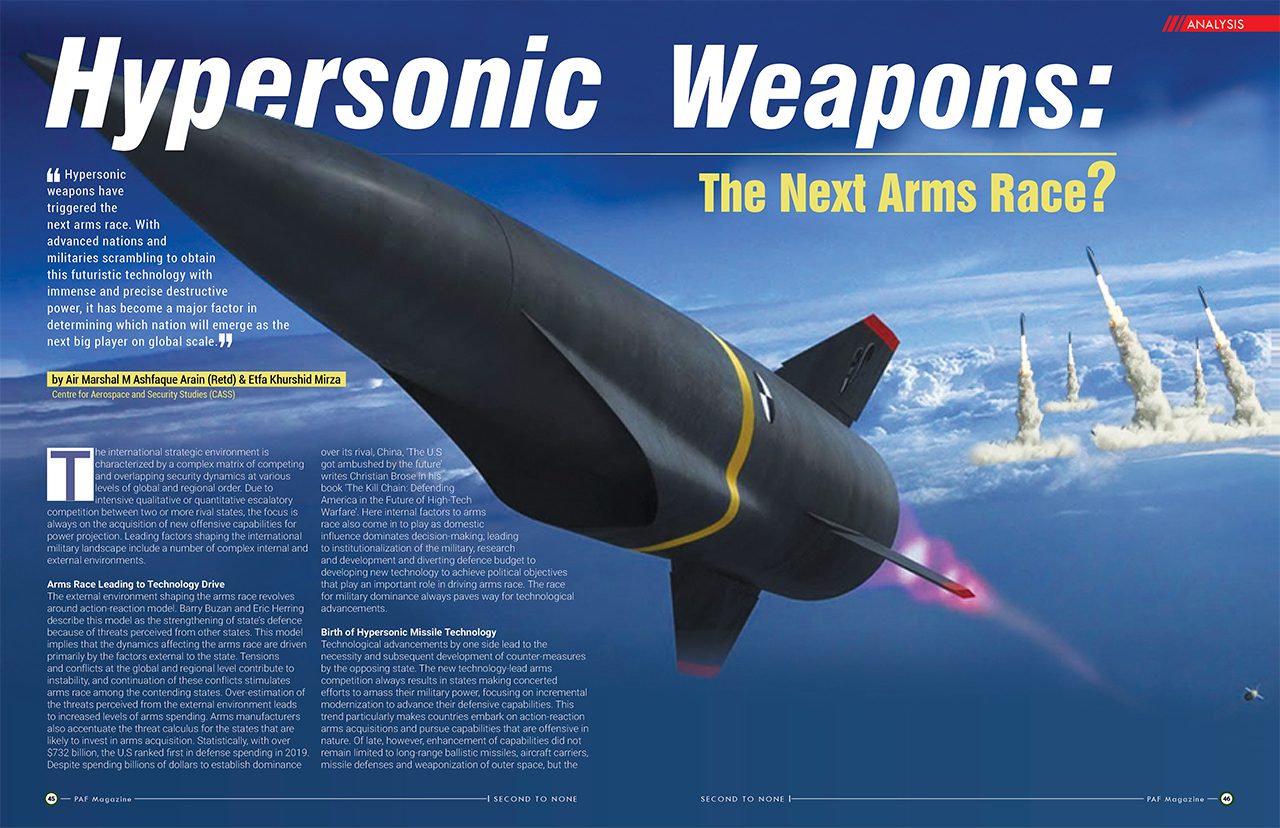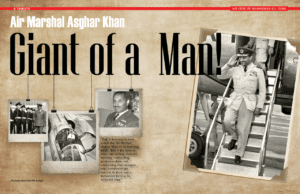Hypersonic weapons have triggered the next arms race. With advanced nations and militaries scrambling to obtain this futuristic technology with immense and precise destructive power, it has become a major factor in determining which nation will emerge as the next big player on global scale.
Ihe international strategic environment is characterized by a complex matrix of competing and overlapping security dynamics at various levels of global and regional order. Due to intensive qualitative or quantitative escalatory competition between two or more rival states, the focus is always on the acquisition of new offensive capabilities for power projection. Leading factors shaping the international military landscape include a number of complex internal and external environments.
Arms Race Leading to Technology Drive
The external environment shaping the arms race revolves around action-reaction model. Barry Buzan and Eric Herring describe this model as the strengthening of state’s defence because of threats perceived from other states. This model implies that the dynamics affecting the arms race are driven primarily by the factors external to the state. Tensions and conflicts at the global and regional level contribute to instability, and continuation of these conflicts stimulates arms race among the contending states. Over-estimation of the threats perceived from the external environment leads to increased levels of arms spending. Arms manufacturers also accentuate the threat calculus for the states that are likely to invest in arms acquisition. Statistically, with over $732 billion, the U.S ranked first in defense spending in 2019. Despite spending billions of dollars to establish dominance over its rival, China, ‘The U.S got ambushed by the future’ writes Christian Brose in his book ‘The Kill Chain: Defending America in the Future of High-Tech Warfare’. Here internal factors to arms race also come in to play as domestic influence dominates decision-making; leading to institutionalization of the military, research and development and diverting defence budget to developing new technology to achieve political objectives that play an important role in driving arms race. The race for military dominance always paves way for technological advancements.
Birth of Hypersonic Missile Technology

Technological advancements by one side lead to the necessity and subsequent development of counter-measures by the opposing state. The new technology-lead arms competition always results in states making concerted efforts to amass their military power, focusing on incremental modernization to advance their defensive capabilities. This trend particularly makes countries embark on action-reaction arms acquisitions and pursue capabilities that are offensive in nature. Of late, however, enhancement of capabilities did not remain limited to long-range ballistic missiles, aircraft carriers, missile defenses and weaponization of outer space, but the major powers went a step ahead in developing technology that is invincible to existing missile defenses due to its extensive manoeuvrability and fast speed i.e. the hypersonic missile technology.
Hypersonic missiles, which include the hypersonic glide vehicles and hypersonic cruise missiles, introduce a new and potent threat to global security. Hypersonic glide vehicles operate on the same principles as the Intercontinental Ballistic Missiles (ICBMs); they use rocket boosters which carry them to the outer atmosphere. After reaching a certain height the glide vehicle separates from the booster, continues to glide and manoeuvre through the space on its own power. Hypersonic cruise missiles (HCMs) are also called air-breathers owing to the scramjet engine which takes oxygen from the atmosphere, mixes it and creates combustion which is necessary to propel the hypersonic cruise missile.
Hypersonic vs. Ballistic Missiles
Hypersonic weapons are different from existing ICBMs due to their high manoeuvrability which makes them perceivably difficult to track and intercept. As present missile defenses are designed optimally to cater to the preeminent threat of ballistic missiles, therefore, hypersonic missiles travelling close to two miles a second are not on their list. The usefulness of hypersonic weapons is due to their ability to strike high-value targets with precision at the onset of war, as the incapacitation of the adversary state helps the other state to get an early advantage at the beginning of the war. Speed is another significant factor which makes hypersonic weapons unique and it will consequently alter the calculus of war and deterrence equation. Due to their disruptive nature and ability to operate in certain areas, (A2/AD strategy) that limit ballistic and cruise missiles, makes hypersonic missiles the weapon of choice to have on inventory for countries like the U.S. The technological determinism and arms competition are driving major countries such as U.S, Russia and China to develop hypersonic weapons to enhance nuclear deterrence and strengthen their military capabilities.
Hypersonic Weapons Development by Major Countries – Strategic Rationale
The Hypersonic Arms Race is currently underway between the major powers of the world, with proven track of technological base coupled with the history of past rivalries as seen in the case of the U.S and Russia.The US and China are now in an all-out competition and the race for scientific and technological supremacy makes their rivalry entirely different from the US-Russia case. Hypersonic weapons program of each country is influenced by a range of motives depending upon its strategic calculus and intended use of these weapons. The U.S is seeking hypersonic weapons to address China’s growing military capabilities and to use these weapons in regional conflicts in conventional capacity. Hypersonic weapons program was part of the U.S global prompt strike program, which entails gaining the ability to target anywhere in the world within sixty minutes after a decision is made. After getting its program sacked due to several failed attempts in testing the hypersonic technology in 2010 and 2011, it got momentum again after Chinese test of the hypersonic glide vehicle DF-ZF. The U.S has again prioritized its hypersonic programme and is once again investing heavily in this technology.

Russia’s strategic manifestation of hypersonic weapons involves global and regional use concomitant of both conventional and nuclear applications. After the U.S withdrawal from the ABM treaty, the U.S missile defences became an eminent threat for Russia’s existing missiles; and to counter the unconstrained U.S missile defences, Russia developed hypersonic missiles. Countering NATO forces in Europe and the Atlantic is another motive for Russian pursuance of this technology. To counter these unwavering threats, Russia is developing various classes of hypersonic missiles to act as Night Witches, a Soviet asset crucial to its success during World War II.
Chinese hypersonic program is focused in a regional context with its hypersonic glide vehicle DF-ZF apparently aimed to counter U.S threat in Asia-Pacific theatre. The end of cold war era envisaged the U.S-China rivalry to overtake the U.S-Soviet competition as the scholars speculated Asia-Pacific region to be ‘ripe for rivalry’. Therefore, the Chinese strategic considerations related to hypersonic weapons are aimed at competing against the U.S forces in the region. Chinese ambitions in hypersonic weapons development are pushing regional states like India to indulge in similar endeavours as well. After the failed February 2019 misadventure against Pakistan, India is seeking hypersonic weapons to undermine Pakistan’s capabilities and to gain an early advantage in conventional domain, while concurrently offsetting China in the technological domain. Indian hypersonic program is at the initial stage at present. Traditionally, India relied on proliferation or cooperation pathways to develop its weapons system; and this time again it is relying on Russia with around 49.5% Russian share in Indian BrahMos-II hypersonic missile development program.
Impact on Regional/Global Peace
The development of hypersonic weapons will increase the cost of war that these weapons would inflict on countries pursuing this trillion dollar arms race in the constrained defense budget era. China and Russia have deployed these weapons as Anti-Access/Area Denial assets to undermine the U.S capability to operate in certain areas and to avoid U.S missile defenses. On the other hand, the U.S is using hypersonic weapons to counter Russian and Chinese A2/AD systems. For the U.S, in order to keep up with its rival states Russia and most pertinently China, it is important to tackle two major challenges. First is to develop and operationalize the hypersonic technology itself, and stay ahead of Russia and China. Second is to develop methods to defend against hypersonic weapons. The potential counter-measures that include directed energy weapons, space-based sensors, high powered lasers, and electromagnetic guns and other means also have offensive applications as well; and their development will once again fuel the arms race dynamics with implications for international security, stability and peace.
Due to their capability to carry both conventional and nuclear warheads, the nuclear ambiguity is likely to lead to miscalculations and trigger pre-emptive strikes contributing to unwarranted escalation. Viewing from the defense economics perspective, each state indulging in hypersonic development race has three major challenges; feasibility, effectiveness and affordability. The development, testing and operationalization of these weapons are very costly, and keeping in view the defence budget constraints, affordability is a major challenge for the states developing such weapons.
Hypersonic missile technology also erodes the on-going and enduring struggle in arms control and disarmament domain.In the present international environment, there is a lack of political will to adopt policies and treaties that prohibit or limit their use. Despite their disruptive nature, there is no mechanism to regulate their development, testing, and production. This will provide, countries like India, a window to acquire this technology in the coming years, eventually having destabilizing effects for the South Asian region. India’s on-going technology fever coupled with arms exports will not only generate arms race in the region but will also push Pakistan to take qualitative and quantitative counter-measures to reinforce its strategic deterrent against India.

Hypersonic weapons affect both components of strategic stability; arms race stability and crisis stability. On one hand, development of the hypersonic weapons by one state will provide thrust for rival states to pursue such technology leading to arms race instability. On the other hand, if a state is under threat of probable hypersonic attack – it would adopt counter-measures which may be destabilizing in nature, hence contributing to crisis instability.
Hypersonic weapons program of all the major powers is motivated by the need to offset the technological supremacy of their opponent. The Bomber Gap rationale from the Cold War era is playing its part in convincing the leadership and military-industrial complexes of these countries to stay ahead or at least equal to each other in military hypersonic technology to avoid catch 22 situation in a crisis. The hypersonic weapons race may take years or decades to reach its operational phase, but it is on, and countries pursuing this spell-binding technology have no other way but to chase it. These weapons will remain a cause of concern for international peace and stability unless stabilising treaties and protocols are established.








